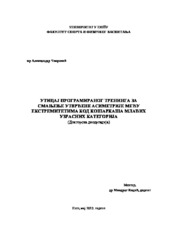Приказ основних података о дисертацији
Uticaj programiranog treninga za smanjenje utvrđene asimetrije među ekstremitetima kod košarkaša mlađih uzrasnih kategorija
| dc.contributor.advisor | Kocić, Miodrag | |
| dc.contributor.other | Jakovljević, Saša | |
| dc.contributor.other | Berić, Dragana | |
| dc.contributor.other | Petković, Dragoljub | |
| dc.contributor.other | Okičić, Tomislav | |
| dc.creator | Čvorović, Aleksandar | |
| dc.date.accessioned | 2022-10-12T19:46:34Z | |
| dc.date.available | 2022-10-12T19:46:34Z | |
| dc.date.issued | 2013-07-06 | |
| dc.identifier.uri | http://eteze.ni.ac.rs/application/showtheses?thesesId=8486 | |
| dc.identifier.uri | https://fedorani.ni.ac.rs/fedora/get/o:1748/bdef:Content/download | |
| dc.identifier.uri | http://vbs.rs/scripts/cobiss?command=DISPLAY&base=70052&RID=533465238 | |
| dc.identifier.uri | https://nardus.mpn.gov.rs/handle/123456789/20734 | |
| dc.description.abstract | Asymmetry in limb use is a phenomenon that is present in daily life, and therefore also in the sport. It´s presence is a consequence of lateralization at the level of the CNS. The primary objective of the study that was realized is to determine the to which extent asymmetry is present in limb use in basketball, and how unilateral type of training impact on the reduction of the same. A secondary objective was to determine how basketball affects on the uneven use of extremities compared to healthy school population that is not actively involved in sports training. Research included 45 boys aged 15, who were divided into three groups: Experimental, Control 1 and Control 2. Tested variables are explosive strength of leg extensors, explosive strength of arm extensors, agility, reaction time and dribbling control. In the experimental group was realized a corrective training, composed of 24 units for a period of eight weeks. The training was focused on the limb that has proven to be a weaker in the initial testing, and training methods were applied: circuit training, working at stations and complex training. The results were analyzed by the coefficient of asymmetry, One Way ANOVA, Mixed Design ANOVA and the percentage difference from the same limb at the initial and final testing. Results of the research indicate that the variables that most influenced by the corrective training are explosive strength of leg extensors and explosive strength of arm extensors, while the other variables were also made progress and have a positive trend in reducing the asymmetry, but not that much. It was also found that basketball has a positive effect in that ages on the level of asymmetry in the use of limbs as opposed to sedentary school population. | en |
| dc.format | application/pdf | |
| dc.language | sr | |
| dc.publisher | Универзитет у Нишу, Факултет спорта и физичког васпитања | sr |
| dc.rights | openAccess | en |
| dc.rights.uri | https://creativecommons.org/licenses/by/4.0/ | |
| dc.source | Универзитет у Нишу | |
| dc.subject | programirani trening | sr |
| dc.subject | programmed training | en |
| dc.subject | asimetrija | sr |
| dc.subject | ekstremiteti | sr |
| dc.subject | košarka | sr |
| dc.subject | efekat | sr |
| dc.subject | asymmetry | en |
| dc.subject | limbs | en |
| dc.subject | basketball | en |
| dc.subject | effects | en |
| dc.title | Uticaj programiranog treninga za smanjenje utvrđene asimetrije među ekstremitetima kod košarkaša mlađih uzrasnih kategorija | sr |
| dc.type | doctoralThesis | |
| dc.rights.license | BY | |
| dc.identifier.fulltext | http://nardus.mpn.gov.rs/bitstream/id/146316/Doctoral_thesis_12059.pdf | |
| dc.identifier.fulltext | http://nardus.mpn.gov.rs/bitstream/id/146317/Cvorovic.pdf | |
| dc.identifier.rcub | https://hdl.handle.net/21.15107/rcub_nardus_20734 |



